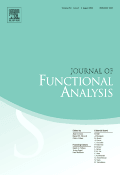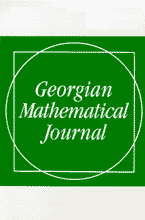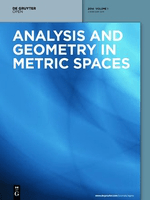
JOURNAL OF FUNCTIONAL ANALYSIS
Scope & Guideline
Pioneering Research in Functional Analysis
Introduction
Aims and Scopes
- Functional Spaces and Operator Theory:
The journal focuses on the study of various functional spaces, including Sobolev, Besov, and Orlicz spaces, and their properties. Research often involves exploring the structure and characteristics of linear and nonlinear operators acting on these spaces. - Nonlinear Partial Differential Equations (PDEs):
A significant portion of the journal's content is dedicated to nonlinear PDEs, including existence, uniqueness, and regularity of solutions. This includes studies on the qualitative behavior of solutions and the application of functional analysis techniques to PDE problems. - Algebraic Structures in Functional Analysis:
The journal explores the interplay between functional analysis and algebra, particularly in the context of C*-algebras, von Neumann algebras, and operator algebras, addressing topics like representation theory, spectral theory, and non-commutative geometry. - Stochastic Analysis and Applications:
Research on stochastic processes, stochastic differential equations, and their applications in various fields, including mathematical physics and finance, is a growing area of interest within the journal. - Geometric Analysis and Metric Geometry:
The journal publishes studies that bridge functional analysis with geometric concepts, including the study of curvature, geometric flows, and metrics in various spaces, emphasizing their analytical properties.
Trending and Emerging
- Advanced Nonlinear Analysis:
There is an increasing focus on advanced topics in nonlinear analysis, particularly concerning variational methods, monotonicity techniques, and the study of nonlocal equations, which are becoming more prominent in recent publications. - Quantum Functional Analysis:
Research at the intersection of functional analysis and quantum mechanics is on the rise, with an emphasis on quantum stochastic calculus, quantum probability, and applications in quantum information theory. - Functional Analysis in Machine Learning:
A growing trend is the application of functional analysis concepts to machine learning, particularly in areas such as regularization techniques, optimization algorithms, and the analysis of neural networks. - Geometric Functional Analysis:
The journal is increasingly publishing studies that combine geometric analysis with functional analysis, focusing on properties of manifolds, geometric flows, and the interplay between curvature and functional spaces. - Stochastic Partial Differential Equations (SPDEs):
Research involving SPDEs is gaining momentum, with a focus on existence, uniqueness, and regularity of solutions, as well as applications to mathematical finance and statistical mechanics.
Declining or Waning
- Classical Functional Analysis Techniques:
There has been a noticeable decline in papers focusing on classical topics such as the theory of bounded linear operators, classical Banach space theory, and the foundational aspects of functional analysis that were previously more prevalent. - Elementary Methods in PDEs:
Research employing elementary techniques for solving PDEs, particularly in the context of classical solutions, seems to be diminishing. There is a shift towards more sophisticated methods, including variational approaches and geometric analysis. - Applications to Classical Physics:
The journal has seen fewer submissions that apply functional analysis directly to classical physics problems, as interest has shifted towards applications in quantum mechanics, statistical mechanics, and modern theoretical physics.
Similar Journals

JOURNAL OF OPERATOR THEORY
Fostering Excellence in Operator Theory ScholarshipJOURNAL OF OPERATOR THEORY is a distinguished periodical published by the THETA FOUNDATION based in Romania. With a specific focus on the realms of mathematics, particularly in the areas of operator theory and its applications in algebra and number theory, this journal plays a crucial role in disseminating high-quality research that advances theoretical understanding and practical applications. It is indexed with an impressive rank of #58 out of 119 in the Scopus Mathematics category, placing it within the 51st percentile nationally. The journal has evolved significantly since its establishment, with publications spanning from 1996 through 2024, and maintaining a reputable stature in the Q2 quartile for Algebra and Number Theory as of 2023. While it operates under a subscription model, the JOURNAL OF OPERATOR THEORY remains an essential resource for researchers, professionals, and students seeking to engage deeply with contemporary mathematical issues and promote advancements in the field. For those looking to explore innovative findings and methodological approaches, this journal is indispensable.

Georgian Mathematical Journal
Advancing mathematical frontiers with rigorous research.Georgian Mathematical Journal, published by Walter de Gruyter GmbH, is a prestigious academic journal dedicated to the field of mathematics, particularly in its multifaceted applications and theoretical explorations. With an ISSN of 1072-947X and an E-ISSN of 1572-9176, this journal is indexed within notable databases and holds a strong position as evidenced by its Q2 ranking in the Mathematics (miscellaneous) category as of 2023 and a ranking of #140 out of 399 in the general mathematics Scopus category, placing it in the 65th percentile for research visibility. Since its inception in 1994, the journal has continued to evolve, aiming to foster innovative research and scholarly communication among mathematicians worldwide. Although it does not offer Open Access, the journal’s commitment to quality and rigor ensures that published works are of high relevance, appealing to researchers, educators, and students who are dedicated to advancing mathematical knowledge across diverse domains.

Topological Methods in Nonlinear Analysis
Bridging Theory and Application in Nonlinear DynamicsTopological Methods in Nonlinear Analysis, published by the NICOLAUS COPERNICUS UNIVERSITY TORUN in collaboration with the JULIUSZ SCHAUDER CENTRE FOR NONLINEAR STUDIES, is an esteemed journal dedicated to advancing the field of nonlinear analysis through topological methodologies. With a strong emphasis on both theoretical and practical implications, this journal aims to bridge the gap between abstract mathematical concepts and their applications across various disciplines. As a part of the rigorous academic landscape, it holds a commendable Q2 ranking in both Analysis and Applied Mathematics, indicating its significant influence among peers. The journal is indexed in Scopus, ranking in the fourth quartile for Mathematics and Applied Mathematics, and appeals to a diverse audience of researchers, professionals, and students eager to explore innovative approaches in nonlinear analytical techniques. The journal has been actively publishing articles since 2009 and continues to elucidate the complex interactions within nonlinear systems, making it a vital resource for the mathematical community seeking to expand their knowledge and contribute to cutting-edge research.

Journal of Mathematical Analysis
Advancing the Frontiers of Mathematical InquiryThe Journal of Mathematical Analysis, published by UNIV PRISHTINES in Serbia, offers a dedicated platform for the dissemination of innovative research in the fields of mathematical analysis and applied mathematics. With an ISSN of 2217-3412 and a convergence period from 2020 to 2024, this journal aims to foster significant advancements in both theoretical and practical aspects of mathematics. Categorized in the Q4 quartile for Analysis, Applied Mathematics, and miscellaneous Mathematics as of 2023, it serves as an essential resource for researchers and professionals alike, providing key insights into the evolving landscape of mathematical inquiry. Although it is an open access journal, facilitating global readership, its Scopus rankings reflect its emerging status, with rankings indicating a 51st percentile in Mathematics (miscellaneous) and 28th percentile in Applied Mathematics. This journal not only aims to contribute to academic discourse but also seeks to bridge gaps between mathematical theory and real-world applications, making it a vital resource for students and professionals engaged in the complexities of mathematical research.

PUBLICATIONS OF THE RESEARCH INSTITUTE FOR MATHEMATICAL SCIENCES
Innovating the Future of Mathematical InquiryPublications of the Research Institute for Mathematical Sciences, ISSN: 0034-5318, E-ISSN: 1663-4926, is a distinguished academic journal published by the European Mathematical Society. Since its inception in 1969, this journal has emerged as a pivotal platform for disseminating high-quality research in the field of mathematics, achieving a notable position in the top quartile (Q1) of the Mathematics (miscellaneous) category as of 2023. With a current Scopus Rank of #121 out of 399, placing it within the 69th percentile for general mathematics, the journal serves as an essential resource for researchers, professionals, and students alike. It aims to foster the advancement of mathematical science through innovative research and comprehensive studies that encourage scholarly dialogue and collaboration. While access options may vary, the journal remains committed to enhancing the visibility and impact of mathematics research on a global scale. Based in Germany, at the Technische Universität Berlin, it continues to uphold a legacy of academic excellence and rigor in mathematical inquiry.

Analysis and Geometry in Metric Spaces
Connecting scholars through rigorous mathematical discourse.Analysis and Geometry in Metric Spaces is a distinguished open-access journal published by DE GRUYTER POLAND SP Z O O, dedicated to advancing the fields of analysis, geometry, and applied mathematics. Since its inception in 2013, the journal has established itself as a vital resource for researchers and practitioners, consistently achieving high rankings in its categories, including Q1 in Analysis and Q2 in Applied Mathematics and Geometry and Topology, with notable Scopus rankings reflecting its impact within the mathematical community. The journal aims to foster scholarly exchange by publishing rigorous research articles that explore innovative trends and significant developments in metric space theory. With continuous open-access accessibility, it ensures that the latest findings are readily available to academics across the globe, thus contributing to the broader discourse within mathematics. As the journal prepares to bridge the years to 2024, it remains committed to serving as a cornerstone for advancements in its scope and a beacon for methodological breakthroughs.

Constructive Mathematical Analysis
Fostering Collaboration Through Open Access to Mathematical InsightsConstructive Mathematical Analysis is a distinguished open-access journal dedicated to advancing the field of mathematical analysis, specifically through constructive methods. Published by Tuncer ACAR and affiliated with Selcuk University in Turkey, this journal has been making a significant impact in the academic community since its inception in 2018. With an emerging presence in Scopus, it has earned a Q2 ranking in key categories including Analysis, Applied Mathematics, and Numerical Analysis for 2023, reflecting its commitment to high-quality research contributions. By providing a platform for innovative research and interdisciplinary approaches, "Constructive Mathematical Analysis" aims to facilitate collaboration among researchers, educators, and students in their pursuit of knowledge in mathematical science. With its open-access model, the journal ensures that research findings are accessible to a global audience, fostering an inclusive academic environment.

Collectanea Mathematica
Unveiling innovative solutions in the realm of mathematics.Collectanea Mathematica is a distinguished academic journal published by SPRINGER-VERLAG ITALIA SRL, dedicated to the field of mathematics, with a specific focus on both applied and theoretical aspects. Renowned for its rigorous peer-review process, the journal aims to advance knowledge in various mathematical disciplines, showcasing high-quality research that significantly contributes to the understanding of mathematical principles. With an impressive impact factor, and categorized in Q1 and Q2 quartiles for miscellaneous and applied mathematics respectively, Collectanea Mathematica plays a vital role in the academic community, catering to researchers, professionals, and students alike. The journal spans its convergence years from 2006 to 2024, reflecting a rich history of excellence and innovation in mathematical literature. With its strategic position within the Scopus rankings, it remains a pivotal resource for those seeking to stay at the forefront of mathematical research.

PUBLICATIONES MATHEMATICAE DEBRECEN
Pioneering Insights in Theoretical and Applied MathematicsPublicationes Mathematicae Debrecen is a renowned international journal published by the University of Debrecen, Institute of Mathematics, situated in Hungary. This journal, with both ISSN 0033-3883 and E-ISSN 2064-2849, has established itself in the field of mathematics since its inception, with coverage extending from 1997 to 2024. Recognized for its rigorous academic standards, it currently holds a Q3 ranking in the mathematics (miscellaneous) category for 2023 and ranks at the 42nd percentile among general mathematics journals in Scopus. Publicationes Mathematicae Debrecen aims to disseminate high-quality research across various areas of mathematics, contributing to the advancement of knowledge and practice in this dynamic field. Although it is not an open-access journal, its readers can access a wealth of scholarly work that addresses both theoretical and applied mathematical issues, making it an invaluable resource for researchers, professionals, and students alike.

Annales Fennici Mathematici
Connecting Scholars through Mathematical ExcellenceAnnales Fennici Mathematici is a prestigious academic journal published by Suomalainen Tiedeakatemia based in Helsinki, Finland. With an ISSN of 2737-0690 and an E-ISSN of 2737-114X, this journal has quickly established itself as an essential resource in the field of mathematics since its inception in 2021. It boasts an impressive Q1 categorization in Mathematics (miscellaneous) for 2023, highlighting its impact among top-tier mathematical publications. Currently, it holds a Scopus rank of #135 out of 399 in General Mathematics, placing it in the 66th percentile among its peers, ensuring visibility and relevance for its published works. The journal is committed to providing a platform for innovative research and the dissemination of mathematical discoveries, making it an invaluable resource for researchers, professionals, and students looking to expand their knowledge and engage with contemporary mathematical challenges.